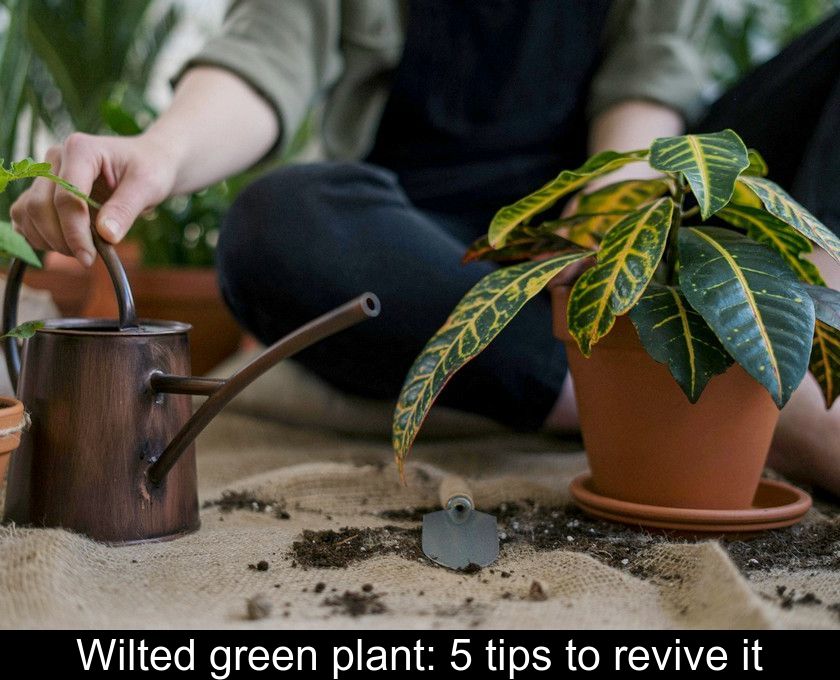Wilted Green Plant: 5 Tips To Revive It
At the end of summer, it is not uncommon for indoor plants to look sad due to the heat and lack of watering during the holidays. If you find a dried-out green plant upon your return, don't throw it directly into the trash! We will give you 5 tips to try to revive it.
1- Cut and clean the leaves
If you find a withered green plant partially or completely upon your return from vacation, don't panic! All hope is not lost as long as there are some healthy leaves and roots left.
The wilting, shriveling, or yellowing of leaves indicates that the plant has suffered in your absence due to a lack of light or watering, but it is not necessarily dead.
The first tip to try to revive it is to give it a bit of grooming. Start by cutting all the dead leaves at the base of the stem. If you're unsure about some leaves, leave them on the plant. Usually, you just need to wait a few days to better distinguish completely dry leaves from those that can regrow.
Clean all the remaining green leaves using a small sponge and non-calcareous water. Ideally, rainwater should be used, but you can also use filtered water with a filtering pitcher...
Note: For severely damaged plants, where only a small part of the foliage has survived, you might consider preserving the species by taking a cutting before discarding the plant.
2- Soak the plant
Once you have cleaned the dried-out green plant by removing all the dead leaves, you can also offer it a bath to rehydrate it. It is very useful to soak the plants to rehydrate the soil clump when it has completely dried out. Preferably use non-calcareous water at room temperature.
Immersing the pot in a container of water like a basin or the bottom of your sink is a good trick to try to revive your green plants, especially if they have lacked watering during your absence and their substrate is very dry...
Also note that this bath should not last too long. A few minutes of soaking is enough. To know when to remove the plant, watch for bubbles escaping from the substrate: as soon as the bubbles stop, it is time to drain the pot!
Let the pot drain completely before putting it back in its cachepot or saucer. Many green plants do not like having stagnant water in their saucer!
3- Give him a glass of sparkling water
If you feel that your dried-out houseplant has lacked water as well as nutrients, you can try another grandmother's trick to revive it: watering with sparkling water.
Different brands of sparkling water contain salts and minerals such as potassium, sodium, and magnesium that are beneficial to plants and can help revive them.
But be careful: before using it for watering, the sparkling water must be completely degassed! To ensure it no longer bubbles, pour it into a small glass and let it sit out in the open air for a long time.
4- Spray the foliage
If your dried-out green plant is one of the species that likes to be misted, you can offer it a light spray on the foliage to try to revive it.
Fill the sprayer with non-calcareous water at room temperature and then mist the leaves lightly.
Caution: after this spraying, do not place green plants under direct sunlight! Place your plant in indirect light, for example behind a window protected by a sheer curtain.
Generally speaking, if a plant's foliage has been burned by the summer sun, it is advisable to move it to the shade or at least out of direct sunlight during its recovery period.
5- Plan for repotting
When you find a dried-out green plant upon returning from vacation, don't throw it away immediately... On the contrary, you need to be patient in the hope of reviving it.
Wait about 3 weeks to see if your plant shows signs of improvement, such as new leaves and buds. If this is the case, you can consider repotting it.
Repotting after its recovery period will allow you to aerate the soil and give the plant fresh potting soil. If you notice that the plant's roots were cramped in the pot, take advantage of this opportunity to replant it in a larger pot.
Note: After suffering from dehydration, green plants remain fragile for about a year. Therefore, you need to provide them with special care and stay vigilant. A plant that nearly died is more susceptible to diseases and insect attacks, so keep an eye out!







